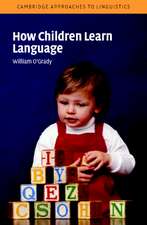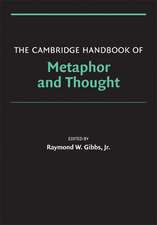The Cambridge Handbook of Psycholinguistics: Cambridge Handbooks in Psychology
Editat de Michael Spivey, Ken McRae, Marc Joanisseen Limba Engleză Paperback – 19 aug 2012
| Toate formatele și edițiile | Preț | Express |
|---|---|---|
| Paperback (1) | 493.74 lei 43-57 zile | |
| Cambridge University Press – 19 aug 2012 | 493.74 lei 43-57 zile | |
| Hardback (1) | 905.99 lei 43-57 zile | |
| Cambridge University Press – 19 aug 2012 | 905.99 lei 43-57 zile |
Din seria Cambridge Handbooks in Psychology
- 23%
 Preț: 1254.71 lei
Preț: 1254.71 lei - 11%
 Preț: 449.49 lei
Preț: 449.49 lei -
 Preț: 502.52 lei
Preț: 502.52 lei - 23%
 Preț: 1248.79 lei
Preț: 1248.79 lei - 8%
 Preț: 426.60 lei
Preț: 426.60 lei -
 Preț: 486.56 lei
Preț: 486.56 lei - 5%
 Preț: 441.42 lei
Preț: 441.42 lei - 9%
 Preț: 1282.44 lei
Preț: 1282.44 lei -
 Preț: 494.25 lei
Preț: 494.25 lei - 8%
 Preț: 429.69 lei
Preț: 429.69 lei - 9%
 Preț: 594.29 lei
Preț: 594.29 lei - 23%
 Preț: 1246.12 lei
Preț: 1246.12 lei - 5%
 Preț: 397.85 lei
Preț: 397.85 lei - 8%
 Preț: 424.41 lei
Preț: 424.41 lei -
 Preț: 501.96 lei
Preț: 501.96 lei - 19%
 Preț: 494.19 lei
Preț: 494.19 lei - 5%
 Preț: 718.49 lei
Preț: 718.49 lei -
 Preț: 511.59 lei
Preț: 511.59 lei - 8%
 Preț: 426.60 lei
Preț: 426.60 lei - 8%
 Preț: 427.05 lei
Preț: 427.05 lei - 8%
 Preț: 425.42 lei
Preț: 425.42 lei -
 Preț: 411.92 lei
Preț: 411.92 lei -
 Preț: 272.35 lei
Preț: 272.35 lei - 8%
 Preț: 425.42 lei
Preț: 425.42 lei -
 Preț: 511.21 lei
Preț: 511.21 lei -
 Preț: 370.88 lei
Preț: 370.88 lei -
 Preț: 374.90 lei
Preț: 374.90 lei - 8%
 Preț: 489.89 lei
Preț: 489.89 lei - 8%
 Preț: 427.49 lei
Preț: 427.49 lei -
 Preț: 511.59 lei
Preț: 511.59 lei - 5%
 Preț: 1538.86 lei
Preț: 1538.86 lei - 23%
 Preț: 2195.06 lei
Preț: 2195.06 lei - 8%
 Preț: 428.36 lei
Preț: 428.36 lei -
 Preț: 488.47 lei
Preț: 488.47 lei - 8%
 Preț: 420.13 lei
Preț: 420.13 lei - 9%
 Preț: 850.12 lei
Preț: 850.12 lei - 8%
 Preț: 430.05 lei
Preț: 430.05 lei -
 Preț: 497.35 lei
Preț: 497.35 lei -
 Preț: 283.03 lei
Preț: 283.03 lei
Preț: 493.74 lei
Nou
Puncte Express: 741
Preț estimativ în valută:
94.51€ • 102.69$ • 79.44£
94.51€ • 102.69$ • 79.44£
Carte tipărită la comandă
Livrare economică 21 aprilie-05 mai
Preluare comenzi: 021 569.72.76
Specificații
ISBN-13: 9780521677929
ISBN-10: 0521677920
Pagini: 760
Ilustrații: 61 b/w illus. 2 colour illus.
Dimensiuni: 178 x 254 x 32 mm
Greutate: 1.32 kg
Editura: Cambridge University Press
Colecția Cambridge University Press
Seria Cambridge Handbooks in Psychology
Locul publicării:New York, United States
ISBN-10: 0521677920
Pagini: 760
Ilustrații: 61 b/w illus. 2 colour illus.
Dimensiuni: 178 x 254 x 32 mm
Greutate: 1.32 kg
Editura: Cambridge University Press
Colecția Cambridge University Press
Seria Cambridge Handbooks in Psychology
Locul publicării:New York, United States
Cuprins
Part I. Speech Perception: 1. Speech perception Carol A. Fowler and James S. Magnuson; 2. Neural bases of speech perception – phonology, streams and auditory word forms Sophie Scott; 3. Learning the sounds of language Jenny R. Saffran and Sarah D. Sahni; Part II. Spoken Word Recognition: 4. Current directions in research in spoken word recognition Arthur G. Samuel and Meghan Sumner; 5. Computational models of spoken word recognition James S. Magnuson, Daniel Mirman and Harlan D. Harris; 6. Finding the words: how young children develop skill in interpreting spoken language Anne Fernald and Michael Frank; 7. Event-related potentials and magnetic fields associated with components and subcomponents that enable spoken word recognition John F. Connolly, Randy L. Newman and Kelly Forbes; Part III. Written Word Recognition: 8. Visual word recognition in skilled adult readers Michael J. Cortese and David A. Balota; 9. Computational models of reading: connectionist and dual-route approaches Mark S. Seidenberg; 10. Decoding, orthographic learning and the development of visual word recognition Kate Nation; 11. How does the brain read words? Rebecca Sandak, Stephen J. Frost, Jay G. Rueckl, Nicole Landi, W. Einar Mencl, Leonard Katz and Kenneth R. Pugh; Part IV. Semantic Memory: 12. The human conceptual system Lawrence W. Barsalou; 13. Computational models of semantic memory George S. Cree and Blair C. Armstrong; 14. Developing categories and concepts Linda B. Smith and Eliana Colunga; Part V. Morphological Processing: 15. Derivational morphology and skilled reading: an empirical overview Kevin Diependaele, Jonathan Grainger and Dominiek Sandra; 16. The neural basis of morphology: a tale of two mechanisms? Anna Woollams and Karalyn Patterson; Part VI. Sentence Comprehension: 17. Individual differences in sentence processing Thomas A. Farmer, Jennifer B. Misyak and Morten H. Christiansen; 18. The neurobiology of sentence comprehension Lee Osterhout, Albert Kim and Gina R. Kuperberg; 19. Computational and corpus models of human sentence comprehension Douglas Roland and Mary Hare; Part VII. Sentence Production: 20. Research in language production Zenzi M. Griffin and Christopher M. Crew; 21. Language production: computational models Gary S. Dell and Joana Cholin; 22. Language production: patient and imaging research Gabriella Vigliocco, Daniel Tranel and Judit Druks; Part VIII. Figurative Language: 23. Figurative language: normal adult cognitive research Raymond W. Gibbs, Jr, Nicole L. Wilson and Gregory A. Bryant; 24. Computational approaches to figurative language Birte Loenneker-Rodman and Srini Narayanan; 25. The development of figurative language Cristina Cacciari and Roberto Padovani; 26. Cognitive neuroscience of figurative language Seana Coulson; Part IX. Discourse and Conversation: 27. Spoken discourse and its emergence Herbert H. Clark; 28. Computational modeling of discourse and conversation Arthur C. Graesser, Danielle S. Macnamara and Vasile Rus; 29. Children, conversation, and acquisition Eve Clark; 30. The electrophysiology of discourse and conversation Jos J. A. Van Berkum; Part X. Language and Thought: 31. How the languages we speak shape the ways we think: the FAQs Lera Boroditsky; 32. Computational approaches to language and thought Terry Regier; 33. Language and cognition in development Dedre Gentner and Stella Christie; 34. Language, thought and … brain? Monica Gonzalez-Marquez.
Recenzii
"...Broad in scope and densely packed, the book covers all areas of psycholinguistic research.... The contributions share clarity and a solid grounding in theory old and new, thus providing readers with a quick way to connect what they already know to what perspective changes the more recent research and analysis provide. Given the increase in imaging research in the last two decades, this handbook stands as a needed update to The Oxford Handbook of Psycholinguistics, ed. by Gareth Gaskell (2007).... Recommended..."
-- J. F. Heberle, Albright College, CHOICE
-- J. F. Heberle, Albright College, CHOICE
Descriere
This comprehensive collection of chapters is written by leading researchers in psycholinguistics from a wide array of subfields.















